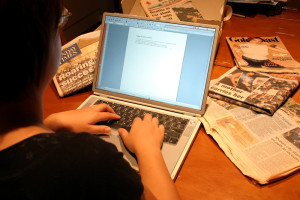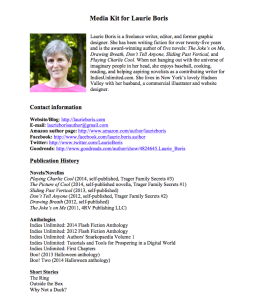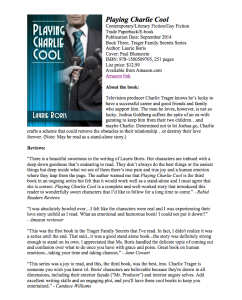 You have a new title out, or you’ve been asked to do a book signing or an interview, maybe participate in a panel discussion — a brilliant opportunity for some publicity. And then someone asks you for a media kit. Gulp. You don’t even know what that is, let alone how to put one together. The good thing is that you probably have all the ingredients for a media kit sitting around on your computer, your website, or floating around on the interwebs. Let’s hunt them down. A quick note first: What I’m walking you through here is only one possible version of a media kit, which is sometimes called a press kit. Your actual mileage may vary.
You have a new title out, or you’ve been asked to do a book signing or an interview, maybe participate in a panel discussion — a brilliant opportunity for some publicity. And then someone asks you for a media kit. Gulp. You don’t even know what that is, let alone how to put one together. The good thing is that you probably have all the ingredients for a media kit sitting around on your computer, your website, or floating around on the interwebs. Let’s hunt them down. A quick note first: What I’m walking you through here is only one possible version of a media kit, which is sometimes called a press kit. Your actual mileage may vary.
Mine is divided into two main sections: Information about me, and information about my books.
For information about you, you’ll need…
A not-hugely-long bio. Think like a busy journalist with limited resources and a deadline. You want to be someone who is easy to work with, and what’s easier than already having a short bio that can be copied and pasted wherever. A couple of non-cumbersome sentences should do it.
Your author head shot. You do have one, right? KS Brooks offers some tips here on how to make yours great.
Your basic professional linkage. That could include:
- Website/blog
- Amazon author page
- Facebook author page
- Twitter address
- Email address (With a note that it’s for contact purposes only, unless you want to take a chance on the whole world trying sell you online dating services or walk-in bathtubs.)
If you’ve done other interviews or written guest posts, include a few links to those. It shows how you’ve presented yourself in the public eye and can give a journalist background if he or she has the time/space to get more in depth. If your opportunity is a radio or TV interview, having a link to something similar can be great. Don’t worry if it’s your first – we all have to start somewhere.
For each book, you’ll need…
- Cover image, probably no more than 500 pixels. (For resizing photos, these tutorials can help)
- Book description, usually the same one from your Amazon page.
- Links to where your book is being sold.
- The ISBN of your book and the retail price.
- A few of your best reviews.
A list of your publications could also be handy. Titles, dates, and where they were published is about all you’ll need, plus any awards you might have won.
Now, for the construction…
You can get all fancy with your desktop publishing programs, but I made my kit in Word and that has been serving me just fine.

I started with my name at the top of the first page: “MEDIA KIT FOR LAURIE BORIS” Easy. Straightforward. I don’t use a pen name, but if you write under one, pop that up there.
After that, I added my head shot, bio, contact info, and publication history. I use a second page to include a few links to past interviews and guest posts, and a list a few of the workshops and panel discussions I’ve done.
Then I give a page to each book. You can create a sell sheet, or, here’s an example of one of mine.

On the last page, I repeat my name, head shot, bio, and contacts. That’s a trick Martin Crosbie taught me, and he’s brilliant at these things. It gives the recipients a last, reinforcing reminder of who you are. Plus it makes it that much easier for media people to get their jobs done. And that’s what we want.
Once your construction is complete, proofread it scrupulously. Make sure your links work. Dead links are really embarrassing. Plus, it annoys journalists if they have to stop what they’re doing and email you because they can’t find what they need.
When I’m finished, I save the document as a PDF file. Before you send it anywhere, check to make sure it’s not HUGE. It will have a few graphics in it, so that can make file sizes unwieldy for emailing. But you can reduce the file size of a PDF either in Adobe Acrobat or several of the other preview utilities available for both PC and Mac.
Now that you have a media kit, think of it as a living, breathing document. Remember to update it when you give a workshop, release a new book, change your sales platforms or your book descriptions, win an award, or get a knock-your-socks-off review.

Excellent post, Laurie! And timely. I’m revamping my website and will use this format for book pages, as well as a press kit. Thanks 😀
Thanks, and good luck!
Thanks for the great tips, Laurie! I’m going to start on my media kit today.
This is great info, Laurie — and timely, as it’s been way too long since I revamped my media kit. Thanks!
Great info, Laurie. I don’t need a media kit yet, but I know plenty of other authors who can benefit from your how-to post. Sharing, everywhere!
Thanks, Laurie. I’ll be needing this soon.
Excellent ideas–concise and to the point. It reminds me that I need to update my info and this is a great way to consolidate it all. Thanks!
Thanks for the hints. I am about to start working on getting more radio interviews for my writing and speaking but first I am going to do this!
I agree with the above comments. Super helpful! Thank you for taking the time to share your knowledge with fellow authors. Much appreciated.
Great info, Laurie. I have started making files for this stuff. Thanks for the budge to actually finish them 🙂
So grateful for the info! Thanks, Laurie!
Thank you for this informative article, Laurie! It will be a great help to many authors.